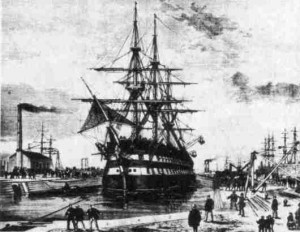- Author
- Bunnett, A, Halliburton, G and Webb, P
- Subjects
- None noted
- Tags
-
- RAN Ships
- HMAS Yarra I, HMAS Nepean, HMAS Lonsdale, HMAS Parramatta I
- Publication
- December 1971 edition of the Naval Historical Review (all rights reserved)
The cofferdam continued to perform its important function until March 1872, when following a south westerly gale, a portion of the north western area collapsed, and the dock was flooded to within four feet of the top of the masonry. It was subsequently discovered that the cofferdam in this section was erected over a vessel that had been sunk at the spot some years before. Four weeks elapsed before repairs were completed. When the water was pumped out, it was found that the masonry had not been appreciably damaged.
The dock was completed on 14th September 1873, but the dock caisson was not finished and in position until February 1874.
The Alfred Graving Dock was built of bluestone, obtained in the district within nine miles of the site.
The dock has an effective length of 476 feet, the distance from the bottom of the dock to the coping of its wall is 35 feet 6 inches, and the depth at low water at the sill is 27 feet 6 inches. It is 100 feet in breadth between the coping tiers of the side walls and 80 feet at the entrance. It cost 341,686 Pounds ($683,372).

The Alfred Graving Dock was officially opened on 2nd March 1874, when HMCS Nelson was docked.
Following the opening of the graving dock, many ships of various sizes and types were docked and repaired over the next 30 years.
A notable project undertaken at the dock was the conversion of Nelson to a single decker in 1881.
A frequent visitor to the dockyard during this period was the monitor HMVS Cerberus.
An interesting visitor was the Russian Warship Afrika, which was docked in February 1882.
During the decade following the opening of the graving dock, the sailing ship was at its height of popularity, and many a clipper ship was docked at Williamstown.
By the end of the 1880s it was apparent that the advent of iron and steel ships and the associated increase in dimensions meant the dock was inadequate for many vessels visiting Melbourne. Efforts were made to interest the authorities in enlarging the graving dock. Early in 1900, the Minister for Customs, Dr. C. Salmon, recommended to Cabinet that the dock be extended by 200 ft. This was not feasible, as much of the dock was constructed on reclaimed land. It was also proposed to build a new 750ft. dock at Williamstown.
In the year 1906, one of the largest undertakings attempted by ship repairers in Australia was successfully accomplished at the Dockyard. SS Peregrine, a 1,660 GRT vessel of the Howard Smith Line, was lengthened amidships by 40 feet. Perhaps the first ‘jumboising’ operation undertaken in Australia.
In addition to docking various types of ships, other jobs undertaken by the Dockyard during the year 1908 included the overhauling of the Queenscliffe lifeboat, and the completion of additions to the St. Kilda Pier in readiness for the arrival, later that year, of the United States Fleet.
On the 29th August 1908, a visiting American Fleet, consisting of sixteen battleships and six auxiliary vessels, steamed up Port Phillip Bay. This was the famous ‘Great White Fleet’ of the USN.
During the `Fleet Week’ celebrations that followed, a collision occurred in Hobson’s Bay on the 4th September between the USN auxiliary Ajax and the steamer SS Leura. The latter vessel was crowded with sightseers.
The tug James Patterson went alongside and took on board the passengers from the SS Leura. The vessel was towed up the river Yarra for repairs. The Alfred Graving Dock was hastily prepared for the Ajax, which proceeded there with pumps working continuously to keep down the in-rushing water. The Ajax was docked and a new stern, 63 feet in length, was constructed and fitted.
The year 1909 ushered in a period of renewed interest by the Commonwealth of Australia in Naval Defence. It was announced by the Minister for Defence on the 5th February that the Government had decided to order Torpedo Boat Destroyers from a shipyard in Great Britain, and intended to undertake the construction of other destroyers in Australia.
This announcement caused widespread interest throughout Australia, particularly in the ship repairing industry. Naval ship construction on such a large scale had not been attempted in Australia previously.
Williamstown Council petitioned the State Government that all efforts be made to secure Naval construction for the dockyard. Proposals were put forward for the preparing of building berths on the site of the old Patent Slipway.
It was not until the 27th January 1910, that the Minister for Defence announced that the third Torpedo Boat Destroyer was to be built in New South Wales, but Victoria would receive a fair share of the work to be carried out by the Federal Government in the future.
On the 14th June 1910, the Victorian Cabinet approved the building of a suction dredge at Williamstown, at an estimated cost of 40,000 Pounds, for the purpose of deepening the port.
It was also intended that the plant, equipment and labour necessary for the building of the Dredge would provide a sound foundation for Victoria’s shipbuilding yard of the future.




